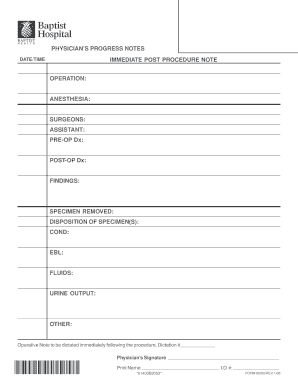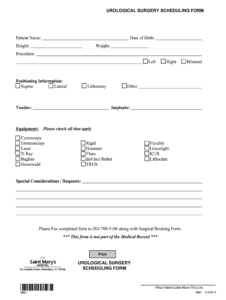Ever felt like you’re swimming in a sea of paperwork after a surgery? You’re not alone! The world of surgical procedures is complex, with countless details to keep track of. From pre-operative assessments to post-operative care, documenting everything accurately and efficiently is crucial for patient safety, legal compliance, and overall quality of care. That’s where a good surgical procedure documentation template comes in handy. It’s like a life raft in that sea of paperwork, helping you stay afloat and on course.

Think of a surgical procedure documentation template as a standardized roadmap for recording all the important information related to a surgery. It’s more than just ticking boxes; it’s about capturing the nuances of each case, ensuring continuity of care, and providing a clear and concise record for future reference. It helps to ensure that all relevant information is captured, reduces the risk of errors and omissions, and improves communication among the surgical team.
But what makes a great template? What essential elements should it include? And how can you customize it to meet the specific needs of your surgical practice? In this article, we’ll explore the ins and outs of surgical procedure documentation templates, providing you with the knowledge and tools you need to create a system that works for you and your team. Let’s dive in and simplify your surgical documentation process!
Why is Comprehensive Surgical Procedure Documentation Essential?
Detailed surgical procedure documentation is more than just a formality; it’s the backbone of safe and effective surgical care. It serves as a comprehensive record of the entire surgical journey, from the initial assessment to the final outcome. This record is vital for numerous reasons, spanning patient safety, legal protection, and continuous quality improvement. Imagine trying to remember the specifics of a procedure performed months ago – without proper documentation, it’s nearly impossible to recall every detail accurately.
Firstly, thorough documentation directly impacts patient safety. A well-documented surgical record ensures that all members of the care team are aware of the patient’s history, allergies, medications, and specific needs. It provides a clear picture of the surgical procedure itself, including any complications that may have arisen and the steps taken to address them. This shared understanding minimizes the risk of errors and promotes coordinated care, ultimately leading to better patient outcomes. For instance, accurately recording the type and amount of anesthesia used can prevent adverse reactions in subsequent procedures.
Secondly, surgical documentation provides crucial legal protection for healthcare providers and institutions. In the event of a legal claim, a detailed and accurate record serves as evidence of the care provided. It demonstrates that the surgical team followed established protocols, made informed decisions, and took appropriate actions throughout the procedure. A comprehensive surgical procedure documentation template helps ensure that all essential information is captured, reducing the risk of liability and protecting the interests of all parties involved.
Furthermore, meticulous documentation is essential for continuous quality improvement. By analyzing surgical records, healthcare providers can identify trends, evaluate outcomes, and implement changes to improve their practices. For example, tracking the incidence of surgical site infections can help pinpoint areas where infection control measures need to be strengthened. This data-driven approach leads to better patient care and enhances the overall efficiency of the surgical department. Regular audits of surgical documentation can also help identify gaps in training or areas where protocols need to be updated.
In addition to these practical benefits, comprehensive documentation also fosters a culture of accountability and transparency within the surgical team. When everyone understands the importance of accurate record-keeping, they are more likely to take ownership of their roles and contribute to the overall quality of care. This shared commitment to excellence ultimately benefits patients and enhances the reputation of the surgical practice.
Key Elements of a Surgical Procedure Documentation Template
A well-designed surgical procedure documentation template should include all the essential information needed to create a comprehensive and accurate record of the procedure. This includes patient demographics, pre-operative assessments, intra-operative details, and post-operative instructions. Think of it like building a house – you need a solid foundation and well-defined structure to ensure its stability. Similarly, your documentation template needs a clear and logical format to ensure all critical information is captured.
First and foremost, the template should include comprehensive patient information, such as name, date of birth, medical record number, and relevant medical history. This helps ensure that the documentation is correctly associated with the right patient. Pre-operative assessments are also crucial, including physical examination findings, laboratory results, and any pre-existing conditions that may affect the surgical procedure. This information helps the surgical team make informed decisions and anticipate potential complications.
The intra-operative section of the template should capture all the details of the surgical procedure itself. This includes the date and time of the procedure, the names of the surgeons and other members of the surgical team, the type of anesthesia used, and a step-by-step description of the surgical technique. Any complications that arise during the procedure should be documented in detail, along with the measures taken to address them. The template should also include space for recording the amount of blood loss, the type and size of any implants used, and the results of any intra-operative tests.
Post-operative instructions are equally important. The template should include clear and concise instructions for the patient regarding wound care, medication management, and follow-up appointments. It should also outline any potential complications that the patient should watch out for and who to contact if they experience any problems. This information helps ensure that the patient receives the appropriate care after the procedure and that they are able to recover safely and effectively.
Finally, the template should include space for signatures and dates to verify the accuracy and completeness of the documentation. It should also be easily customizable to accommodate the specific needs of different surgical procedures and surgical practices. A surgical procedure documentation template isn’t a static document; it should evolve with your practice and adapt to new technologies and best practices. By including all of these key elements, you can create a comprehensive and reliable surgical record that protects your patients and your practice.
By embracing a well-structured template, you streamline the process of capturing the essence of each surgery, leaving less room for ambiguity and promoting clarity across the board.
Ultimately, a well-crafted surgical procedure documentation template becomes more than just a form; it’s a safeguard for patients and practitioners alike, ensuring a cohesive and informed surgical journey.



